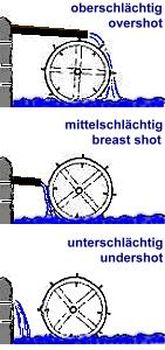Water-wheels and Water-mills
( A bit of history and functioning )
The oldest mechanical equipment allowing people to harness natural forces was the water-mill. The knowledge of the water-mills traveled from Mediterranean region to northern Europe. This invention already must have been made in the 1st Century B.C.. The Roman master-builder and engineer Vitruv (1st Century B.C.) describes a water-mill in his "Architectura" in full technical details. This type of water-mill maintained the its original form until the first half of the 19th Century. The core of the water-mill system is a vertically positioned water wheel whose rotation is transformed by a cogwheel to drive the grinding-/mill-stone. Even though the exact origin is not known, the combination of a vertical water-wheel, gear transmission and rotary mill is undoubtedly a Roman invention. Therefore, the general basis had been established for all future water, wind, animal, and manually operated mills equipped with cogwheels. The water-mills had first an undershot wheel for the drive. The turning point in the history of the water-mill, however, is the transition from the single blade wheel to the so-called bucket wheel (or cell wheel.) This construction exploits both the water flow and the water weight. The water-mills were already in widespread use in the early Middle Ages, i.e. in the 8th and 9th century.
 Overshot wheel:
Overshot wheel:
The water is channeled to the top of the wheel and the energy of the falling water is thus transferred and moves the wheel through its own weight.
Efficiency up to 75 %.
Breast-shot wheel:
The water falls onto the shovels at half heights of the water-wheel (at level of the half shaft).
Backshot wheel:
The water falls below the wheel vertex, in approximately ¼ of the wheel height on the backside into the shovels.
Undershot wheel:
The water-wheel is positioned in such a way that the flowing water pressure will move the wheel upwards.
Efficiency of up to 35 %.
With these four featured modes of driving of the millwheel, the horizontal rotational movement is so already generated.